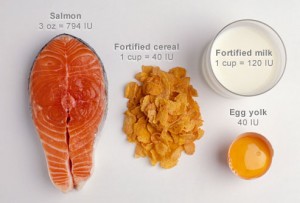Guide to Vitamin D Deficiency
The below article has been kindly offered by Laura Chapman of KwikMed, a freelance health writer.
Although most of us meet our vitamin and mineral requirements without too much difficulty, there is one exception. Increasing numbers of us are developing a deficiency of vitamin D, with research estimating that more than 40% of Americans are deficient in this vitamin. This is perhaps not surprising though, as there are few foods that are a natural source of vitamin D and although the action of sunlight on our skin is a reliable source, many of us do not receive enough sun exposure to meet our needs. This isn’t just an issue for our bone health, as it is now recognized that vitamin D may protect against a wide range of health problems.
Why is vitamin D important?
Although vitamin D is best known for helping your body to absorb calcium, essential for preventing conditions such as rickets and osteoporosis, this is only one of its important roles. For example, low levels of vitamin D are associated with raised blood pressure, which is a risk factor for heart disease, stroke and kidney disease. This may partly explain why people deficient in vitamin D are more susceptible to cardiovascular disease, though low vitamin D status also increases the build up of calcium in your arteries. Similarly, low levels of vitamin D may predispose you to type 2 diabetes, cases of which are also on the increase, but the mechanism for vitamin D’s involvement is unclear. It is equally not clear whether vitamin D deficiency is a cause or a consequence of obesity.
However, the three conditions for which there is most convincing evidence of a link with vitamin D is cancer, multiple sclerosis and seasonal affective disorder. Adequate levels of vitamin D may protect against cancers affecting the breast, colon, pancreas, prostate and skin and there is also evidence that post-menopausal women taking vitamin D and calcium supplements may receive protection against any type of cancer. Meanwhile, higher levels of vitamin D seem to offer protection against multiple sclerosis, as does taking a daily vitamin D supplement. Finally, if you suffer from low mood in the winter months and have a diagnosis of seasonal affective disorder, lack of vitamin D production may explain the link between sunlight and this mood disorder, as several studies show that taking vitamin D supplements improves symptoms of SAD.
As the connection between vitamin D and a range of chronic health problems is still only relatively recent, further research is needed to confirm its role beyond bone health. However, as the vitamin shows great potential for protecting against a range of common conditions, preventing and identifying cases of vitamin D deficiency is essential.
Who is most at risk?
While vitamin D deficiency affects a large proportion of the population, some people are more susceptible to it than others. Firstly, anyone who spends most of their time indoors, whether that is due to ill-health, a busy work schedule or for another reason, misses out on the opportunity to generate vitamin D through their skin. This is also the case if you cover your skin when you go out or you always apply sunscreen, as this blocks the majority of vitamin D production. Equally, if you have a darker tone to your skin, this acts as a natural sun block and slows synthesis of vitamin D; this probably explains the higher rates of deficiency among African Americans and Hispanics. However, where you live also makes a difference to your ability to make vitamin D, as at higher latitudes you will struggle to manufacture any vitamin D during late autumn and winter. Finally, as you age vitamin D
production is less efficient and if you have excess body weight, this also increases your risk of deficiency.
Can you prevent deficiency?
Although it is harder to prevent a deficiency of vitamin D if you are already at increased risk, there are still steps you can take to boost your levels of vitamin D. For instance, aim to include foods rich in vitamin D in your diet each day. Oily fish, such as salmon, sardines and tuna, naturally contain good amounts of vitamin D, with smaller amounts available from eggs and liver. A range of foods are also fortified with vitamin D, including milk, orange juice, breakfast cereals and margarine. Additionally, although you may be reluctant to expose your skin to the sun without using sunscreen, experts advise that you actually need very little sun exposure to generate enough vitamin D. For example, just 5 or 10 minutes in the sun 3 times each week during the spring, summer and fall, where you expose your arms and legs, can meet your vitamin D requirements, which should not place you at risk of burning. However, the safest way to prevent deficiency is to take a daily vitamin D supplement, which supplies 600 IU of the vitamin or 800 IU if you are over 70.
How can you recognize vitamin D deficiency?
Even if you have vitamin D deficiency, you may not necessarily realize it, as the symptoms are often vague, including fatigue and muscle aches. With a more advanced deficiency, you may also develop bone pain and weakness, which can make mobility difficult, as well as repeated infections. However, the only reliable way to know whether you are deficient in vitamin D is to visit your doctor who can check levels of the vitamin in your blood. If you belong to one of the ‘at risk groups’, it is wise to get your vitamin D levels tested.
How can you correct a deficiency?
While upping your intake of vitamin D rich foods and getting out in the sun more can help to prevent deficiency, if a blood test shows your vitamin D levels are already low, you will need a high dose supplement to restore your levels. You will usually receive 50,000 IU of the vitamin weekly for 8 weeks, along with 1500mg of calcium daily. If your blood levels have normalized after 8 weeks, you will receive a lower maintenance dose of vitamin D to prevent further deficiency.
Category: Healthy diet, Supplements









